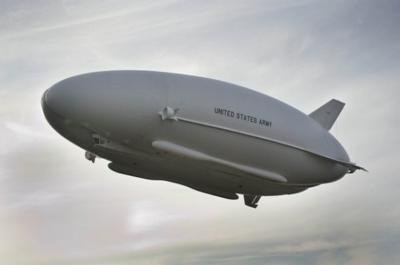Fri, Aug 10, 2012
Medium-Altitude-Long-Endurance Lighter-Than-Air Aircraft Can Operate Manned Or Unmanned
In its first flight, the Army's hybrid air vehicle known as the Long Endurance Multi-Intelligence Vehicle, or LEMV, stayed aloft over Joint Base McGuire-Dix-Lakehurst, NJ, for more than 90 minutes on August 7. The LEMV, like a blimp, is capable of carrying multiple intelligence, surveillance and reconnaissance payloads for more than 21 days at altitudes greater than 22,000 feet. The U.S. Army Space and Missile Defense Command/Army Forces Strategic Command conducted the first flight test of vehicle.

"Murphy Bays" on the LEMV can carry just about any kind of sensor or equipment, and design specifications for the LEMV require the vehicle to provide up to 16 kilowatts of electrical power for those payloads. The LEMV is intended to be used to conduct long-term Intelligence, Surveillance, and Reconnaissance, or ISR, and persistent stare-type missions, and can also be used as a communications relay.
The primary objective of the first flight was to perform a safe launch and recovery of the LEMV. A secondary goal was to verify the flight control system operation. Additional objectives included airworthiness testing and demonstration, as well as system-level performance verification. All objectives were met during the first flight.
The football field-sized LEMV can operate at altitudes greater than 22,000 feet above mean sea level, has a 2,000 mile radius of action, can carry a 2,750 pound ISR payload for more than 21 days, and boasts a fuel consumption that is more than 10 times less than comparable capabilities. Design requirements for the LEMV include providing up to 16 kilowatts of electrical power for payload, as well as runway independence.
The LEMV is designed to be a recoverable and reusable multi-mission platform. It can be forward located to support extended geostationary operations from austere locations and capable of beyond-line-of-sight command and control. During this first flight, the LEMV was manned, though the air vehicle can also operate unmanned.
Following a planned and detailed inspection of the vehicle, there will be additional manned flights.
(Image provided by the U.S. Army)
More News
Its Offerings Are Lighter, Cleaner, and Now Pushing Past 1,000nm on SAF Jet Fuel DeltaHawk’s diesel-powered aircraft lineup has seen incredible upgrades over the last few yea>[...]
The Airplane Experienced A Total Loss Of Engine Power On December 3, 2025, about 1600 central standard time, a Mooney Aircraft Corp. M20K, N57229, was substantially damaged when it>[...]
Make Sure You NEVER Miss A New Story From Aero-News Network Do you ever feel like you never see posts from a certain person or page on Facebook or Instagram? Here’s how you c>[...]
Aero Linx: European Society of Aerospace Medicine (ESAM) As a pan-European, independent forum, it works to promote the safety and health of all persons involved in aviation and spa>[...]
“We are excited to see Wisk achieve this milestone, and I’m so proud of the team that made it possible. The team at Wisk has built advanced technologies across flight c>[...]
 Aero-TV: DeltaHawks Diesel Power Steps Into the Spotlight
Aero-TV: DeltaHawks Diesel Power Steps Into the Spotlight NTSB Prelim: Mooney Aircraft Corp. M20K
NTSB Prelim: Mooney Aircraft Corp. M20K ANN FAQ: Turn On Post Notifications
ANN FAQ: Turn On Post Notifications ANN's Daily Aero-Linx (12.20.25)
ANN's Daily Aero-Linx (12.20.25) Aero-News: Quote of the Day (12.20.25)
Aero-News: Quote of the Day (12.20.25)



